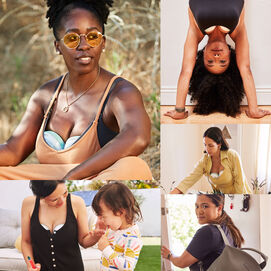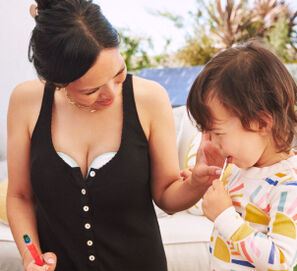News flash: flat and inverted nipples are common! And guess what? They are just as beautiful as protruding nipples. We know that it's easy to pick apart any so-called abnormalities on our bodies, but realistically, you will be able to breastfeed just fine.
In this blog we cover how to breastfeed with flat or inverted nipples. From the impacts on milk supply, to latching tips, we cover all of the FAQs from mamas like you.
What Are Flat Nipples?
A flat nipple does not protrude and appears even with the areola. You can test to see if your nipple is flat by gently squeezing it between your fingers. Nipples that are not flat will protrude when stimulated. If your nipple is flat, it will remain even with the areola.
Types of Flat Nipples
Some flat nipples are congenital, while others can occur for various health reasons, below are the most common:
-
True Flat Nipples
True flat nipples are present from birth. Flat nipples can still be stimulated through arousal or cold temperatures, but they will not protrude. Sometimes nipples may appear flat if your baby licks them before feeding, but this does not mean they are truly flat.
-
Engorgement
Breast engorgement can cause nipples to flatten. Engorgement can be uncomfortable, and even painful. New mamas generally experience breast engorgement during the early days of breastfeeding. Expressing milk by hand or pump before a feeding session can help your baby latch.
Impact on Breastfeeding
Flat nipples generally do not have an impact on breastfeeding. When feeding, babies are able to draw the nipple out even if it lays flat. Tools like breast shells and breast pumps can also help to make the latching process easier.
Impact on Milk Supply
While flat nipples should not have an impact on your baby's ability to breastfeed, it may take longer for your baby to learn to efficiently feed. Over time, this may negatively affect your milk supply. Latching problems are common, and it may take some time for your baby to learn to properly breastfeed.
If you suspect that your baby's breastfeeding is impacting your milk supply, be sure to check in with your doctor or lactation consultant to establish a plan.
What Are Inverted Nipples?
Inverted nipples appear concave instead of pointing out. Some women have an inverted nipple on one breast, while others have inverted nipples on both sides.
Inverted nipples are categorized by classes. These classes are divided into three grades:
- Grade 1: Nipples can be easily popped out through stimulation or cold weather.
- Grade 2: Nipples can be popped out, but not as easily as Grade 1 nipples. These nipples will also retract quickly after being pulled out.
- Grade 3: Nipples cannot be pulled out, and the milk ducts are small and restricted. People with Grade 3 inverted nipples may not be able to breastfeed, and may require surgery.
What Causes Inverted Nipples?
Some people may be born with inverted nipples. In these cases, nipples may be inverted for life, or will disappear with age. If the inversion doesn't reside after puberty, some people get surgery to correct the nipple. This isn't always required for breastfeeding, but it can also be for social or cosmetic reasons.
If the nipple becomes inverted later on in life, this may be a cause for concern. If there are other symptoms like nipple erosion or discharge, it's best to seek medical attention immediately. These could be early signs of cancerous or abnormal cell growth.
Impact on Breastfeeding
If you have Grade 1 or Grade 2 inverted nipples, this should not negatively impact your ability to breastfeed. The inversion does not impact the milk ducts, which means your body will still be able to produce milk.
Because Grade 3 nipples impact the growth of milk ducts, this may require extra medical attention if you plan on breastfeeding. We recommend working with your doctor and lactation consultant to establish a plan for feeding your baby.
Impact on Milk Supply
Similar to flat nipples, inverted nipples will only have a negative impact on your milk supply if your baby struggles to latch. A poor breastfeeding latch means that your baby is not efficiently breastfeeding. Because milk production is on a supply and demand basis, this can decrease the amount of milk you produce over time.
Willow 360™ Wearable Breast Pump
Willow 360™ Wearable Breast Pump
Willow 360 is designed with a zero-gravity latch to give you 360° of leak-proof mobility. It's the hands-free breast pump that changed the game.
Breastfeeding With Flat or Inverted Nipples
Breastfeeding with flat or inverted nipples can be tricky, but it is possible! For a better experience while breastfeeding, below are some of our tips and tricks for breastfeeding with irregular nipples.
Latching
The essential step to making sure your baby is breastfeeding efficiently is ensuring they have a deep latch. A deep latch means your baby's mouth is fully open, around the areola. Their nose should rest on your breast with their lips puffed out like a fish. You can also experiment with different breastfeeding positions to help achieve this deep latch.
For flat or inverted nipples, you can also try using your thumb and forefinger to gently squeeze your nipple. This can help to stimulate it before your baby is ready to feed.
Expression
Doing a quick pump before breastfeeding can help to elongate your nipples, making it easier for your baby to latch. This can be very quick, just a couple seconds on each side should work!
You may also try hand expressing before a breastfeeding session. This is especially helpful if your breasts are engorged. You may also try hand expressing after a feeding session to ensure that your breasts are fully drained. This is an important step if your baby is struggling to latch.
Let down
To encourage milk let down, try laying on your side, especially if you have larger breasts. When preparing to breastfeed, make sure you are warm and comfortable. It's common for cold temperatures to make nipples numb, which means they may be less likely to protrude on their own. Sitting in a warm bath or placing warm wash cloths on your breasts can help to encourage milk let down.
You're a superhero, mama. Breastfeeding is challenging, but the crew at Willow is here to help. Visit the Willow blog to find answers to more of breastfeeding and pumping questions. Or, stop by our Instagram to say hello to the Willow community! We can't wait to be friends, mama.
Get pumping support with Simplifed
Get pumping support with Simplifed
Get access to free virtual feeding support from the lactation consultants at Simplifed. They can help you navigate supply issues, introduce a bottle, and more, and are trained on Willow pumps.















